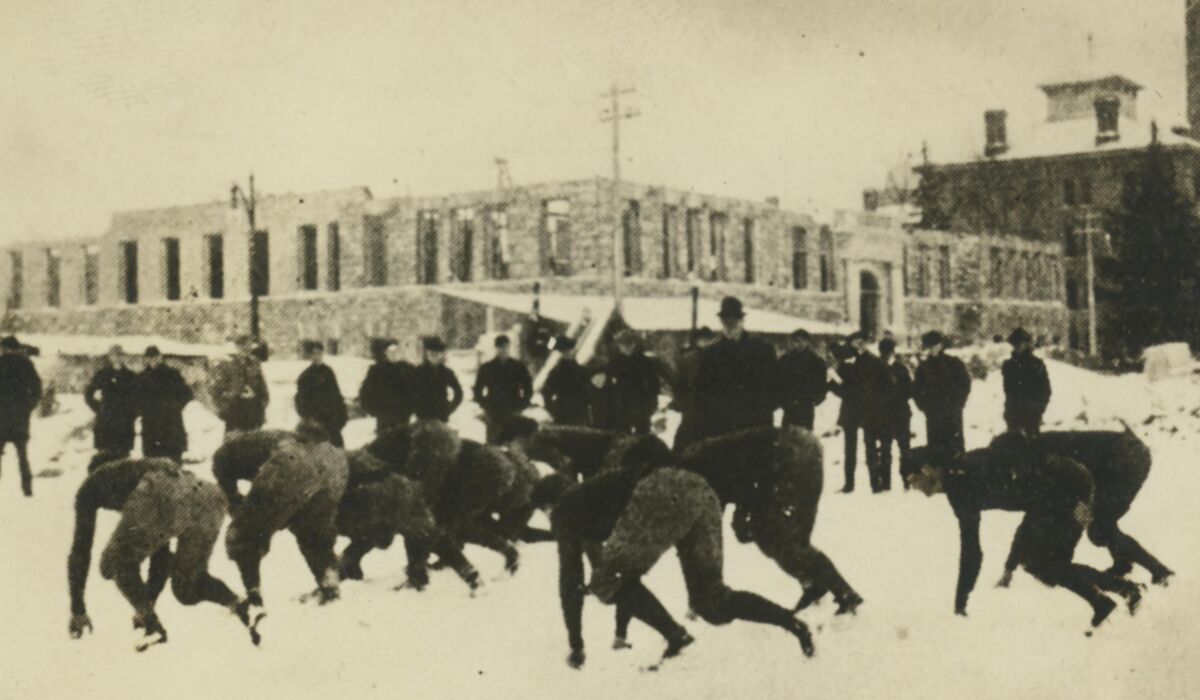In 1841, four years after its move from Detroit, the University of Michigan’s first classes in Ann Arbor began. More than 180 years later, countless footsteps and copious construction have shaped the heart of the nascent 40-acre campus into the Diag we know today.
The President’s House was one of the original structures built for the University and is the oldest still standing today. It was one of the few buildings seen by students crossing the Diag to get to class, but it wasn’t long before these crossroads began to transform into one of the most vibrant spaces on campus. For Fielding H. Yost, the relatively flat, unobstructed, and snow-covered Diag at the turn of the 20th century was a suitable place for his football players to practice before heading to California for the first-ever Rose Bowl — then known as the Tournament East-West football game — on Jan. 1, 1902. The “Point-a-Minute” Wolverines would go on to defeat Stanford University 49-0.
As the U-M campus grew, so did the Diag’s role as a gathering place for public expression, such as a 1930s rally to garner support for the Spanish Republic as it fought an uprising backed by Hitler and Mussolini, a June 1989 gathering to protest violence in China’s Tiananmen Square, or the 2024 Gaza solidarity encampment that lasted nearly a month before University law enforcement, citing fire safety concerns, moved in to remove it. In August 1942, student volunteers used a Grounds Department-constructed “bomb shelter” to sell war stamps to support the U.S.’ involvement in World War II. As part of the University community’s memorial services for Martin Luther King Jr. following his assassination in 1968, U-M students utilized the Diag as a site to raise funds for the Poor People’s Campaign, King’s proposed initiative to highlight the need for economic security as part of civil rights.
The Diag has also served as a gathering spot in times of challenge and mourning. On the night of Sept. 11, 2001, an estimated 15,000 people congregated on the Diag in the first of many communal vigils to support each other and mourn the lives lost in the terror attacks of that morning. The names of the 18 U-M alumni known to have died in the attacks are enshrined in a plaque at the Alumni Center.
The Diag’s importance to the Ann Arbor campus has long made it a desirable site host to festivals and events as well. Spring Commencement activities have been held at Michigan Stadium since 1950, but a new venue was needed in 2008 due to heavy construction at the Big House. The public pushed back against initial plans to utilize Eastern Michigan University’s Rynearson Stadium. Consequently, for the first time ever, the Diag was prepped to host 30,000 attendees for the annual celebration of new alumni.
While the Diag commencement might have been a one-off, the Diag is also host to traditions. On the first Saturday in April, the Diag is home to Hash Bash: a festival for supporters of marijuana legalization and related causes. The event’s direct story began on March 9, 1972, when the Michigan Supreme Court ruled the law used to convince poet and activist John Sinclair, ’64, to a decade-long prison sentence for marijuana possession was unconstitutional. In addition to freeing Sinclair (who was imprisoned for more than two years), the ruling temporarily upended marijuana’s legal situation in the state until new laws took effect that coming April. Legalization supporters saw an opportunity in the meantime to garner momentum for the movement. Hash Bash continues as both an annual celebration and a rally for federal legalization.
One of the most well-known U-M traditions, in fact, has to do with the Diag’s center seal. Before the iconic bronze M, a tile M monogram held its place, but that was removed in 1952 as the University redesigned the walkways around the General Library — now known as the Harlan Hatcher Graduate Library. The current M seal was officially dedicated as a gift from the senior class of 1953 on May 11, 1953. As the legend goes, students should avoid stepping on the bronze M to avoid failing their first blue book exam.
There is no way to chronicle all the events and connections — big and small, impromptu and planned, mournful and joyful — that have occurred on the Diag over almost two centuries, cementing the importance of this campus center and its inextricable place in the history of the University and its people.
Gregory Lucas-Myers, ’10, is the senior associate editor of Michigan Alum.





